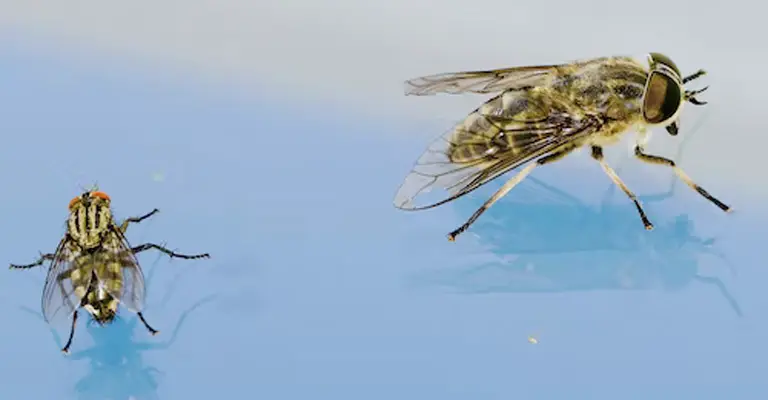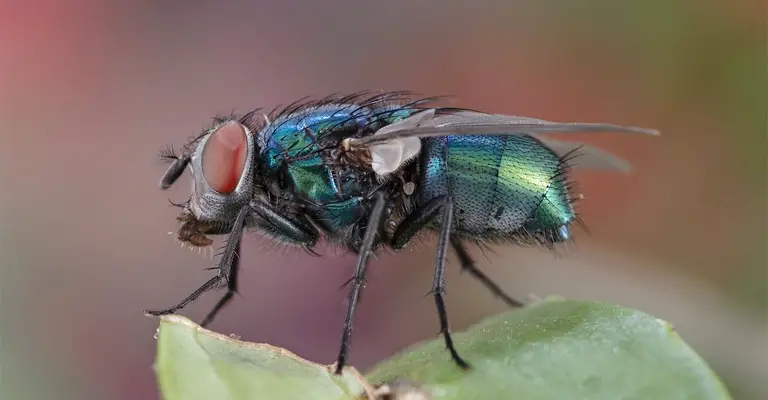Flies can enter a home or building through open doors, windows, or other openings. They can also crawl through small cracks and crevices around windows, doors, and the foundation of a building.
It is also possible for flies to be attracted to food or garbage inside a home, which can serve as a breeding ground for them. To find out where the flies are coming from, you can try the following steps:
- Look for open doors or windows where flies could enter the building.
- Check for any cracks or gaps around windows, doors, and the foundation of the building, and seal them if possible.
- Look for any food or garbage sources that might attract flies. This could include dirty dishes, open containers of food, or trash that needs to be disposed of.
- Consider using fly traps or fly paper to catch and remove flies already inside the building.
- If the problem persists despite your efforts to eliminate potential entry points and sources of attraction, you may want to consult a pest control professional for further assistance.
Recommended Products
1. Fly Traps
2. Door Sealer
Why Do I Suddenly Have So Many Flies In My House?

The flies return just as the weather starts getting nice again. They are thousands. Their numbers are hundreds of thousands. Especially around your home, they are everywhere.
Are these flies? Where do they come from? Whoa, why now? The most important question is, what can you do about them? Nothing to worry about. Let us help you with your fly questions.
Let’s hope we can keep your spring fly-free. Several different types of flies infest most people’s homes. Different types of flies want different things and behave differently:
Phorid Flies
There is a similarity between phorid flies and fruit flies. These two smalls, tan-colored, red-eyed species are very small (1/16 to 1/8 inches). In addition to light, garbage, and humidity, phorid flies are attracted to heat.
Blowflies
Summer and spring are the most common seasons for blowflies. Their color is metallic green, blue, or copper, and their size is somewhere between 1/4 and 1/2 inches.
Fruit Flies
Specifically, Drosophila melanogaster is one of the most common fruit flies to infest houses. The flies have yellow or orange eyes and measure 3-4 millimeters long.
They’re tan or clear-colored flies with yellow or orange talons. Liquids fermenting, especially sugary liquids, are the habitat of fruit flies.
House Flies
Michigan houses are infested by house flies, one of the most common insect pests. They are 1/8 to 1/4 inches long, dark gray, broad flies with dark stripes and dark red eyes.
It is most common to find them living in garbage, especially in moist or rotting organic matter. This spring, these are likely to be the culprits for any fly problem you may be experiencing.
Where Did These Flies Came From?
Most of the flies present in your home were likely born there. Food sources near thin moisture films are ideal places for them to lay their eggs.
As the eggs hatch, their offspring feed and grow rapidly until adulthood. When the adult insects reproduce, the cycle begins all over again.
For the first generation to start reproducing, they must enter your home somehow. One of two things can happen to cause that.
To begin with, pests are very good at detecting changes in temperature and smelling out rotten food. They will wiggle inside small cracks that smell like rotting food after following the smell to drafts.
What Do These Flies Want?
As you’ve probably noticed, these flies have a few things in common. Is that the big one? Waste. Many fly species love living around garbage, reproducing in it, and eating it.
It is more specific than they enjoy moist, rotting, or fermenting organic matter. Their attraction is to any garbage decaying, breaking down, or starting to smell.
Even a thin film of moisture is enough for flies to live off of and produce eggs. A leaky pipe or condensate from a draft can produce enough runoff to satisfy the need.
Fly larvae usually nest in rotting material or humidity within your home if you have them in your home. In most cases, flies reproduce indoors continuously and frequently whenever possible.
Why Are They Here Now?
Temperature is the most important factor determining how quickly a fly’s life cycle unfolds. Fly species complete their life cycles extremely rapidly during warm seasons.
The life cycle of houseflies, for example, may take up to ten days from egg to adult. A hotter and longer summer leads to more pests growing, mating, and spreading.
A fruit fly, for example, can lay up to 500 eggs in one season. During spring and summer, they reproduce especially frequently because of the warm outdoor temperatures. This isn’t just a problem with you; they are everywhere.
What Can I Do About These Flies?
Keeping pests out of your home, especially when moisture is present, is the key to controlling them. A fly’s favorite place to find moisture is near garbage or other food sources. When garbage cans aren’t in use, keep them sealed.
Be sure to take out your garbage every night before sleep. Make sure that containers are rinsed and dried before disposal. Ensure there aren’t any leaks in the plumbing system or other runoff sources.
You should check under kitchen and bathroom sinks, particularly around garbage. Your home may require a dehumidifier if certain areas are particularly humid. Prevent any other sources of excess moisture by cleaning up and preventing them.
Flies will use whatever they can find, no matter how small it appears. Fly infestations can be extremely difficult to manage once they have become established.
The problem with finding fly eggs is that they hatch quickly, so you’ll have a new generation to deal with once they hatch.
Preventing pests from reproducing in your home is much easier than attempting to eliminate them later. It is possible to do just that if you follow these tips.
How To Get Rid Of House Flies?
To control house flies, the first step is to exclude them and keep them clean. After these measures, you can then use residual insecticides, aerosols, fogging materials, and baits.
It has been a favorite for many years to keep flytraps. It is possible to purchase fly traps in many forms, such as disposable and electronic fly light traps with replaceable light bulbs.
First Step: Exclusion and Sanitation
It is imperative to maintain good sanitation as the first line of defense. Despite various traps and sprays that kill flies, eliminating the source is the best way to eliminate them.
It is important to remove or destroy all suitable materials for laying eggs; this will isolate the egg-laying adult flies. For effective House Fly control, you must eliminate breeding areas and kill adult flies.
Fly Control Products
At night, house flies come inside or sit under eaves and rest on sunny surfaces. Depending on where the flies are resting, residual or contact insecticides can be sprayed.
As the flies rest on the surface that has been sprayed, they pick up enough insecticide that kills them. It is important to spray surfaces with enough water to ensure runoff but not so much as to form puddles.
In addition, you can use dust such as D-Fense Dust. Incorporate this into any cracks or crevices. As the dust flows into the void areas, it will accumulate there. Ensure all openings on the west and south walls are caulked.
Aerosol and space sprays with pyrethrins are the best options for immediate results. Although pyrethrins work quickly, they do not leave a lasting residue.
Using these aerosols as a fast-kill insecticide allows you to reduce flying insects’ populations in the short term.
Call Your Local Exterminator
Depending on the severity of the infestation, you might need the help of a pest control company if you cannot eliminate houseflies by using the above measures.
When you hire your local pest control company to eliminate those filthy flies, you’ll keep yourself and your family safe.
Final Words
In addition to fresh manure, rotten fruits and vegetables, garbage, damp garbage, and decaying organic materials outside the house, house flies can be found feeding and breeding.
House flies usually enter structures from the outside, so finding them is common. Ensure that there are no cracks around windows, doors, and vents that could allow entry.
To prevent livestock from breeding in buildings, finding out where the breeding sources are located and how they enter is crucial.
Farms in rural areas make them more vulnerable to breeding site contamination than in urban areas. It is common for house flies to breed in residential areas where pet manure is not regularly picked up.








